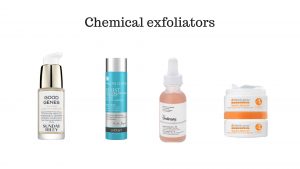Exfoliation is one of my favourite steps in my skin care regimen. My first foray into exfoliation was using Apricot Scrub as a teenager. I remember asking my mom to get me a jar because the cool girls in my school used it. Now I cringe when I think of using the harsh jagged scrub on my face.
With time I learnt about the different types of exfoliation and I will discuss why exfoliation such an important part of a skincare regimen as well as the pros and cons of each method.

Exfoliation
Human skin goes through a shedding process naturally but tends to slow down with age. This reduction in shedding leads to a build-up of cells on the surface of your skin leading to dull and sometimes congested skin. Regular exfoliation removes dead cells from the surface of your skin leaving it smoother allowing serums and treatments to penetrate more easily.
Regular exfoliation helps maintain texture, lighten pigmentation and reduce the appearance of fine lines and wrinkles. It is also useful for acne caused by blocked pores because it pore-clogging dirt thus reducing acne. Exfoliation is particularly beneficial for oily skin because it helps remove excess oils from the skin restoring the natural balance. The benefits of exfoliation are not exclusive to oily skin alone, all skin types can benefit as long as you choose a suitable method which does not increase sensitivity.
Types of exfoliation
There are two main types of exfoliation physical or chemical exfoliation
Physical Exfoliation
Physical exfoliation is the most commonly used and utilizes friction using either a tool or an abrasive agent to loosen or remove the dead skin cells exposing new skin.
Face scrubs: are the commonest type of physical exfoliation and utilize creams or face scrubs made from coffee grounds, salt or sugar. To prevent micro-tears and damage to the skin the abrasive agent used should be smooth with no sharp edges. When done improperly or too often physical exfoliation may cause inflammation and hyperpigmentation.

Face Brush here the bristles serve as the exfoliating tool and can be done manually or with an electric brush. The Clarisonic is the most popular exfoliating brush is which took the skincare world by storm spawning, several copycats. It also serves double duty as a face cleanser and with the brush attachment providing exfoliation. The Clarisonic has different brush heads for specific skin types and works best for oily and normal skin.
Microdermabrasion is another method of physical exfoliation which unlike scrubs is usually done in a professional capacity. A tool utilizes abrasive crystals (usually aluminium or magnesium oxide) to refine pores to improve the appearance of acne scars. Because of its popularity, there is a home microdermabrasion tool that which allows you to do it in the comfort of your home.
Chemical Exfoliation
Like it says chemicals like enzymes and acids are used to dissolve the outermost layer of skin to encourage cell turnover bringing new cells to the skin’s surface. It is recommended for acne-prone skin because it is less traumatic with less irritation. Acids like AHAs and BHAs as well as retinol are commonly used for chemical exfoliation.
Alpha Hydroxyl Acids (AHAs)
Are the most commonly used chemical exfoliator which eliminates dead skin cells caused by sun damage. AHAs normalize cell turnover in the epidermis and stimulate the formation of healthy skin. AHAs come in different forms and strengths and can be used as daily/weekly exfoliants or as professional chemical peels.

Beta Hydroxy Acids (BHA)
This is another commonly used acid which penetrates into the skin to clear sebum from the follicle and exfoliate the pores. Salicylic acid is the BHA of choice for acne-prone skin.
Retinol (Vitamin A)
Although retinol is not in the same category as hydroxy acids, its method of action has exfoliation as a side effect. Retinol is converted to retinoic acid which acts as a potent skin exfoliant, improving signs of sun damage.
How Often Should You Exfoliate?
The frequency of exfoliation primarily depends on your skin type, however, the rule of thumb from dermatologists is at least once a week. This allows you to get the benefits of exfoliation, and clear skin without over-exfoliation. Physical exfoliation is more likely to cause over-exfoliation and hyperpigmentation and is more problematic for dry and normal skin. However, people with oily skin are able to exfoliate more frequently due to the excess oils but should be kept to a maximum of twice a week.

Dangers of Over-Exfoliating
The goal of exfoliation is to restore the natural exfoliation process of the skin. When done properly cell turnover is optimized thereby making skin smoother and well-hydrated. Over-exfoliation may cause additional skin issues like hyperpigmentation, especially for people with darker skin tones. Evidence suggests that over-exfoliation may lead to increased sebum production and a weaker barrier function allowing acne-causing bacteria to penetrate pores leading to more acne.
There you have it, the types, benefits and challenges of exfoliation in a nutshell. If you enjoyed this post and would like to get more skincare and beauty tips subscribe and follow me on social media.

Skin Barrier Damage is a real thing, so learning how to exfoliate your skin the right way is key.
This Guide shows you the do’s and the don’t ensure you get it right.